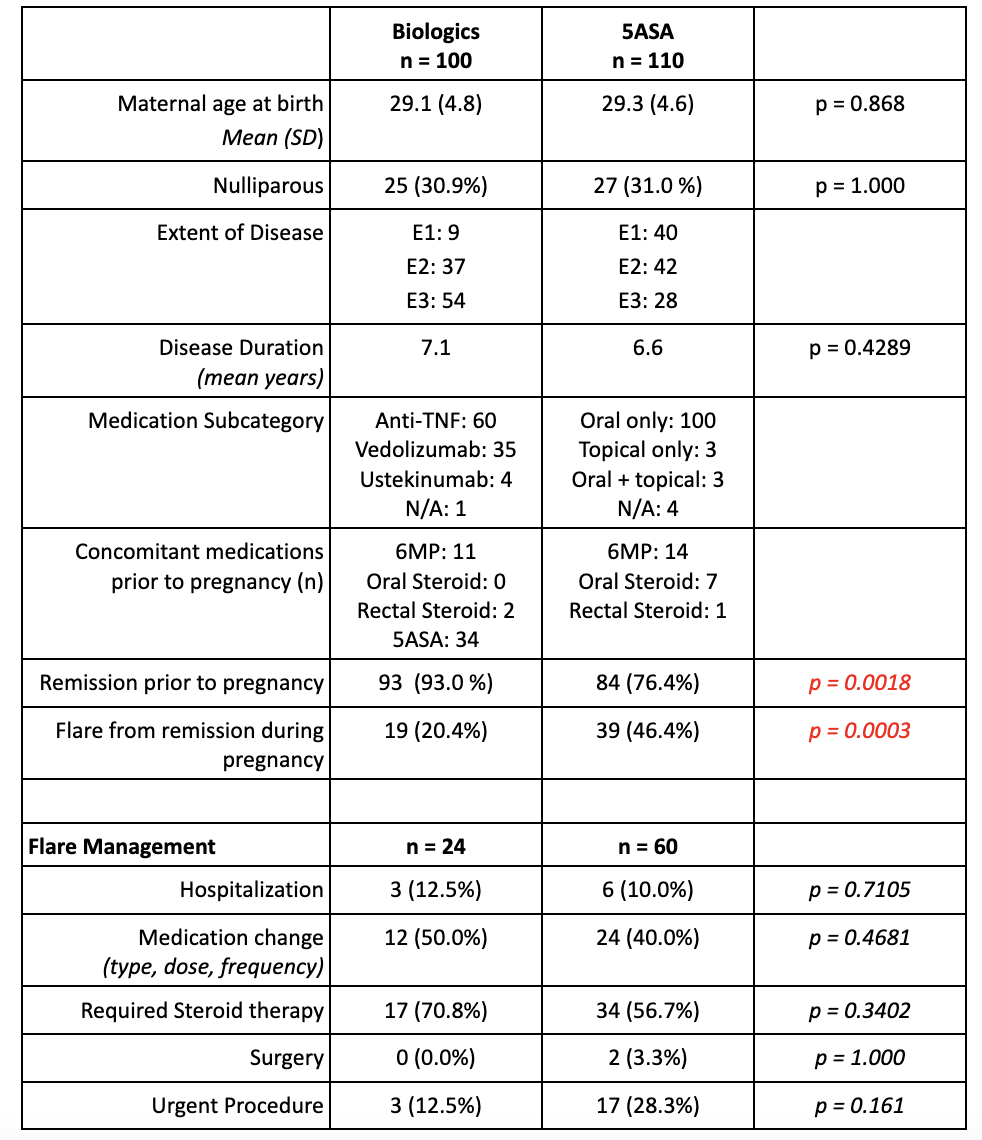Monday Poster Session
Category: IBD
P3269 - Rates of Flares During Pregnancy Are Higher Among Women With Ulcerative Colitis Maintained on 5-ASA vs Biologics
Monday, October 27, 2025
10:30 AM - 4:00 PM PDT
Location: Exhibit Hall

Elena F. Cattaneo, BS, BA (she/her/hers)
University of Minnesota Medical School
Saint Paul, MN
Presenting Author(s)
Award: ACG Presidential Poster Award
Elena F. Cattaneo, BS, BA1, Hofit Elimeleh Ben-Kimon, 2, Haakon H. Sigurslid, BA1, Eugenia Shmidt, MD3, Ariella Bar-Gil Shitrit, MD4
1University of Minnesota Medical School, Saint Paul, MN; 2The Hebrew University of Jerusalem, Shoham, HaMerkaz, Israel; 3University of Minnesota, Minneapolis, MN; 4Shaare Zedek Medical Center, Jerusalem, Yerushalayim, Israel
Introduction: Studies have shown that pregnancy may increase the risk of flare in women with ulcerative colitis (UC) and that biologic use may be protective against a flare during pregnancy, but no comparative data exist on the rate of flare during pregnancy between those on 5-Aminosalicylic acid (5-ASA) therapy versus biologics. We aimed to compare disease-related outcomes during pregnancy among women on 5-ASA vs. biologic maintenance therapy for UC. Pregnancy related complications were the secondary outcomes.
Methods: We retrospectively reviewed the charts of pregnant women with pre-existing UC who delivered at one of two participating Inflammatory Bowel Disease (IBD) pregnancy clinics in the USA and Israel between January 1, 2015 and Dec 1, 2024. We identified patients who were maintained on 5-ASA or a biologic at conception. Among those on a biologic, the medication was continued throughout the entire duration of pregnancy. We collected demographic data, disease activity and pregnancy outcomes and analyzed these data using chi-square tests, student’s t-tests, or fisher’s exact tests as appropriate, considering a p value < 0.05 as significant.
Results: We identified 210 pregnancies in patients with previously diagnosed UC treated with a biologic or 5-ASA (110 on biologics, 100 on 5-ASA). Patients on biologics were significantly more likely to be in remission prior to pregnancy than patients on 5-ASA (93.0% vs 76.4%, p = 0.0018). Among those who were in remission at conception, the rate of flare was lower in patients on maintenance therapy with a biologic vs. 5-ASA (20.4% vs 46.4%, p = 0.0003) (Table 1). When comparing neonatal and obstetric outcomes between patients on biologics versus 5ASA, there was no significant difference in infant birth weight (3274g vs 3192g, p = 0.2873), gestational age (39.1 weeks vs 38.7 weeks, p = 0.1645), rates of preterm birth (5.2% vs 9.4%, p = 0.3928), low birth weight (4.2% vs 8.5%, p = 0.3449), and rates of cesarean delivery (20.0% vs 15.2%, p = 0.4847).
Discussion: Patients on biologics for UC are more likely to be in remission prior to pregnancy compared to those on 5-ASA medications. Additionally, biologics may be protective against a flare during pregnancy, even among those in remission at conception. These findings underscore the importance of achieving remission prior to pregnancy and may also suggest an important role of biologics in preventing active disease in pregnancy.

Figure: Table 1. Demographics and disease-related outcomes during pregnancy among women on 5-ASA vs. biologic maintenance therapy for ulcerative colitis.
Disclosures:
Elena Cattaneo indicated no relevant financial relationships.
Hofit Elimeleh Ben-Kimon indicated no relevant financial relationships.
Haakon Sigurslid indicated no relevant financial relationships.
Eugenia Shmidt: Bristol Myers Squibb – Grant/Research Support.
Ariella Bar-Gil Shitrit: AbVvie – Consultant, Speakers Bureau. Ferring – Speakers Bureau. Janssen – Consultant, Speakers Bureau. Lilly – Speakers Bureau. Padagis – Speakers Bureau. Rafa – Speakers Bureau. Takeda – Consultant, Speakers Bureau.
Elena F. Cattaneo, BS, BA1, Hofit Elimeleh Ben-Kimon, 2, Haakon H. Sigurslid, BA1, Eugenia Shmidt, MD3, Ariella Bar-Gil Shitrit, MD4. P3269 - Rates of Flares During Pregnancy Are Higher Among Women With Ulcerative Colitis Maintained on 5-ASA vs Biologics, ACG 2025 Annual Scientific Meeting Abstracts. Phoenix, AZ: American College of Gastroenterology.
Elena F. Cattaneo, BS, BA1, Hofit Elimeleh Ben-Kimon, 2, Haakon H. Sigurslid, BA1, Eugenia Shmidt, MD3, Ariella Bar-Gil Shitrit, MD4
1University of Minnesota Medical School, Saint Paul, MN; 2The Hebrew University of Jerusalem, Shoham, HaMerkaz, Israel; 3University of Minnesota, Minneapolis, MN; 4Shaare Zedek Medical Center, Jerusalem, Yerushalayim, Israel
Introduction: Studies have shown that pregnancy may increase the risk of flare in women with ulcerative colitis (UC) and that biologic use may be protective against a flare during pregnancy, but no comparative data exist on the rate of flare during pregnancy between those on 5-Aminosalicylic acid (5-ASA) therapy versus biologics. We aimed to compare disease-related outcomes during pregnancy among women on 5-ASA vs. biologic maintenance therapy for UC. Pregnancy related complications were the secondary outcomes.
Methods: We retrospectively reviewed the charts of pregnant women with pre-existing UC who delivered at one of two participating Inflammatory Bowel Disease (IBD) pregnancy clinics in the USA and Israel between January 1, 2015 and Dec 1, 2024. We identified patients who were maintained on 5-ASA or a biologic at conception. Among those on a biologic, the medication was continued throughout the entire duration of pregnancy. We collected demographic data, disease activity and pregnancy outcomes and analyzed these data using chi-square tests, student’s t-tests, or fisher’s exact tests as appropriate, considering a p value < 0.05 as significant.
Results: We identified 210 pregnancies in patients with previously diagnosed UC treated with a biologic or 5-ASA (110 on biologics, 100 on 5-ASA). Patients on biologics were significantly more likely to be in remission prior to pregnancy than patients on 5-ASA (93.0% vs 76.4%, p = 0.0018). Among those who were in remission at conception, the rate of flare was lower in patients on maintenance therapy with a biologic vs. 5-ASA (20.4% vs 46.4%, p = 0.0003) (Table 1). When comparing neonatal and obstetric outcomes between patients on biologics versus 5ASA, there was no significant difference in infant birth weight (3274g vs 3192g, p = 0.2873), gestational age (39.1 weeks vs 38.7 weeks, p = 0.1645), rates of preterm birth (5.2% vs 9.4%, p = 0.3928), low birth weight (4.2% vs 8.5%, p = 0.3449), and rates of cesarean delivery (20.0% vs 15.2%, p = 0.4847).
Discussion: Patients on biologics for UC are more likely to be in remission prior to pregnancy compared to those on 5-ASA medications. Additionally, biologics may be protective against a flare during pregnancy, even among those in remission at conception. These findings underscore the importance of achieving remission prior to pregnancy and may also suggest an important role of biologics in preventing active disease in pregnancy.

Figure: Table 1. Demographics and disease-related outcomes during pregnancy among women on 5-ASA vs. biologic maintenance therapy for ulcerative colitis.
Disclosures:
Elena Cattaneo indicated no relevant financial relationships.
Hofit Elimeleh Ben-Kimon indicated no relevant financial relationships.
Haakon Sigurslid indicated no relevant financial relationships.
Eugenia Shmidt: Bristol Myers Squibb – Grant/Research Support.
Ariella Bar-Gil Shitrit: AbVvie – Consultant, Speakers Bureau. Ferring – Speakers Bureau. Janssen – Consultant, Speakers Bureau. Lilly – Speakers Bureau. Padagis – Speakers Bureau. Rafa – Speakers Bureau. Takeda – Consultant, Speakers Bureau.
Elena F. Cattaneo, BS, BA1, Hofit Elimeleh Ben-Kimon, 2, Haakon H. Sigurslid, BA1, Eugenia Shmidt, MD3, Ariella Bar-Gil Shitrit, MD4. P3269 - Rates of Flares During Pregnancy Are Higher Among Women With Ulcerative Colitis Maintained on 5-ASA vs Biologics, ACG 2025 Annual Scientific Meeting Abstracts. Phoenix, AZ: American College of Gastroenterology.

